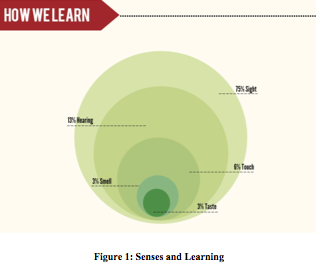Come to Your Senses with 3D Printing
Senses are the primary means that humans use to gain new knowledge. Sight, hearing, touch, smell and taste work together to give us a full picture of our experiences. Indeed, we rarely gain any knowledge using one sense alone. Figure 1 reveals that 75% of learning is achieved through sight, while the next most important senses are hearing and touch.
In most classrooms today, teachers emphasize learning through sight and hearing; sight through visual representation on the board or with a video, and hearing through discussing a topic in class. This teaching method works great in all areas except science, technology, engineering and mathematics (STEM). Indeed, STEM fields require the presence of physical models to maximize the learning experience through the added sense of touch.
There is a variety of physical models currently available to students in STEM, through science laboratory, engineering machine shops and museums, as well mini science kits. But what about schools with limited budgets that cannot afford field trips to the museum or the maintenance of a science laboratory? What if students could build the physical models themselves and understand by ‘doing’?
3D printers are the easy and relatively cheap solution to bring physical models to the STEM classroom. NVBOTS takes on this challenge by building a database of 3D printable objects and lesson plans to be incorporated in high school STEM curricula. For the past eight weeks, the design interns at NVBOTS have been designing physical models to fulfill learning objectives in the various areas of STEM, such as physical sciences, planetary and earth sciences, engineering and life sciences.
To me, the importance of 3D printed models became a lot more evident in the past two weeks, while designing for life sciences. Biology is the area of STEM that I find the least intuitive. It was inspiring to see and touch 3D printed models of concepts I found very challenging in high school, such as the full mechanism of DNA replication.
In my team, we designed a 3D model to illustrate the life cycle of a virus. The said model is displayed in pictures below:
1. Virus
2. Cell
We offer Lesson Plans to go along with our printable models, including the Virus Life Cycle of the one shown above.

